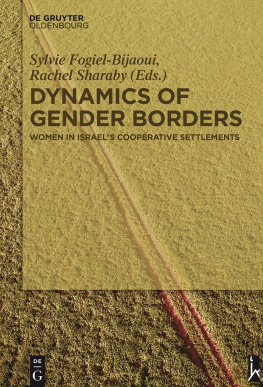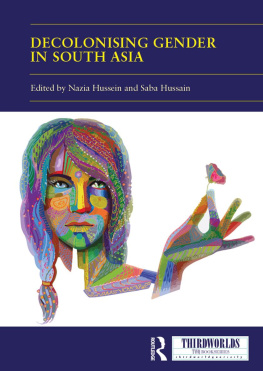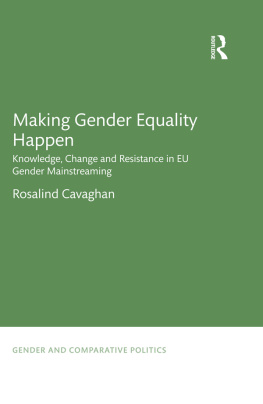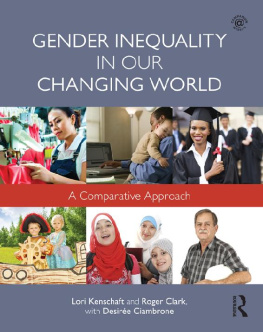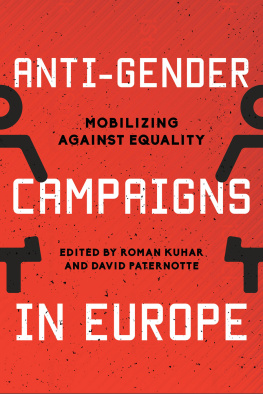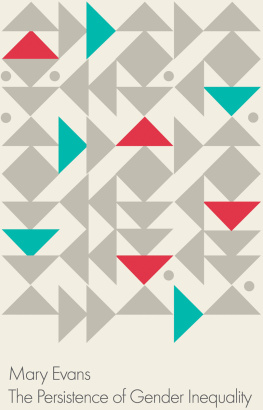ISBN 978-3-11-046375-0
e-ISBN (PDF) 978-3-11-046621-8
e-ISBN (EPUB 978-3-11-046409-2
Library of Congress Cataloging-in-Publication Data
A CIP catalog record for this book has been applied for at the Library of Congress.
Bibliographic information published by the Deutsche Nationalbibliothek
The Deutsche Nationalbibliothek lists this publication in the Deutsche Nationalbibliografie;
detailed bibliographic data are available on the Internet at http://dnb.dnb.de.
2017 Walter de Gruyter GmbH, Berlin/Boston
www.degruyter.com
www.magnespress.co.il
Acknowledgments
This book had its genesis in a work meeting held some years ago at Yad Tabenkin, the Research and Documentation Center of the United kibbutz movement, at which the two of us discussed the gendered history of the kibbutz and the moshav with our dear friend Dr. Menachem Topel, head of the Social Studies Department at Yad Tabenkin. By the end of that conversation, the three of us had decided to create a research group on how gender borders have been (re)produced at the heart of these utopian socialist-inspired communities.
Things moved fast, as talented scholars from diverse disciplines, including literature, history, sociology, political science, anthropology, geography, and media, joined our research group. For two years we met at Yad Tabenkin more or less regularly, to learn together and from one another about the kibbutz, the moshav, and their changing gender regimes. Ultimately, we decided to publish the fruits of our respective studies and our captivating debates as a collective volume in Hebrew. Expertly edited by Yaacov Setter, Private and public: Women in the kibbutz and the moshav (Bein haperati latziburi: Nashim bakibutz uvamoshav) was published in 2013 by Yad Tabenkin in collaboration with the Hebrew UniversityMagnes Press. Meanwhile, we began to think about publishing our book in English, as a contribution to the production of knowledge about gender and utopia. Now this ambitious project has come to fruition, and we are deeply grateful for the continuous support we have received.
We would like to thank our colleagues and friends at Yad Tabenkin, where the project has been based, including Ms. Yona Prital, the Director of Yad Tabenkin; Dr Abigail Paz-Yeshayahu, the head of the Research Department; and Dr Menachem Topel, the head of the Social Studies Department, who from the start enthusiastically supported our research group and the publication of our work, in Hebrew and then in English. We are greatly indebted to the Hebrew UniversityMagnes Press and to its director, Hai Tsabar, for their continuing faith in this academic venture. Hai Tsabars exceptional cooperation, assistance, and guidance made our collaboration with the Hebrew UniversityMagnes Press and our approach to De Gruyter Oldenbourg Publishing House easy and pleasant. We extend our deep and sincere thanks to De Gruyter Oldenbourg Publishing House and especially to our editor there, Dr. Julia Brauch, who specializes in Jewish Studies and the history of the twentieth century, with whom we have become accustomed to an efficient, highly professional, and cordial approach that makes things happen (immediately).
We also thank Monika Pfleghar, De Gruyter's production editor, for her kind and expert help in walking us through the publication process.
We are most thankful to the authors, who have come a long way with us, sparing neither time nor effort, and always with a smile. Their commitment made this project possible, and their talent added new and original perspectives to our field of research. Our special thanks go to the Research Committees of the College of ManagementAcademic Studies, Rishon Lezion, and of the Ashkelon Academic College for their financial assistance, without which this book would not have been possible. We are also very grateful to the anonymous reviewers of Yad Tabenkin, the Hebrew UniversityMagnes Press and De Gruyter Oldenbourg Publishing House for their careful reading of our manuscript (in Hebrew and in English, respectively) and for their insightful suggestions, which helped us to improve our work. Profound gratitude goes also to Deborah Greniman and Gail Diamond for their work on translating and editing the manuscript. They are partners in the wealth of material presented here and were pivotal associates in the books completion. Thanks also to Esther Rosenfeld for expertly proofreading most of the manuscript.
Two important individuals are no longer with us to receive our thanks: Naama Hadad-Kedem (Kibbutz Beeri) and Eli Avrahami (Kibbutz Palmachim). Naama, who co-authored the article Change and reproduction of gender roles in moshavim of immigrants from Islamic countries with Rachel, passed away in 2016. Eli, who contributed so much to Sylvies paper, The politics of cooptation: The kibbutz movements gender equality departments, 19822015, passed away in 2015. They live on in our memories and hearts as they do in the memories and hearts of all who loved them. To them and to all the wonderful people who joined us on this intellectual and collegial journey, we can only say: Thank you!
Sylvie Fogiel-Bijaoui and Rachel Sharaby
Contents
Sylvie Fogiel-Bijaoui and Rachel Sharabi
Tsafrira Shaham
Lilach Rosenberg-Friedman
Yaffah Berlovitz
Rachel Sharaby
Bat-Sheva Margalit Stern
Anat Granit-Hacohen
Rachel Sharaby and Naama Hadad-Kedem
Esther Schely-Newman
Tzipi Saada and Michael Sofer
Avi Shnider
Gali Palti
Menachem Topel
Sylvie Fogiel-Bijaoui
Sylvie Fogiel-Bijaoui and Rachel Sharabi
Introduction
Reconstructing the Private and Public Spheres
Challenging gender borders in the pre-state period
The kibbutz and the moshav are collective, voluntary, socialist-inspired forms of settlement that grew out of the Jewish national movement in Palestine. The kibbutz movement, founded in 1910 with the creation of its first collective settlement at Degania, strove to implement, democratically, the egalitarian principles expressed in the slogan From each according to his ability, to each according to his needs. To live up to these values, the kibbutz (pl.: kibbutzim) developed a unique model in which social institutions, including major household services, were restructured on a collective basis, creating such emblematic institutions as childrens houses with communal sleeping quarters, the communal kitchen and dining room, and the communal laundry. All women were part of the workforce, and members of couples were economically independent of each other. Economic rewards were equal for all and independent of the prestige of ones occupation; and, at least formally, women had the same rights and duties as men in the kibbutz democracy.
The moshav movement, founded in 1921 with the establishment of the settlement of Nahalal, set out to create agrarian socialist communities that combined fundamental elements of individual and cooperative settlement. Eliezer Yaffe (Yaffe 1919), the founder, defined those elements: state-owned land, independent work, mutual help, cooperative purchasing and marketing of produce, and cooperative institutions. The moshav (pl.: moshavim) institutionalized a less radical socioeconomic system than the kibbutz did. The family or household, not the individual, remained the basic unit of production and consumption. The founders of the moshav movement, too, cherished the value of gender equality. They felt that it could be implemented by husbands and wives performing agricultural tasks together and making joint decisions at the level of the individual farm.

